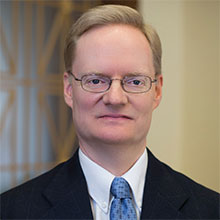The Great Inflation
The history of the St. Louis Fed, particularly in the 1960s and 1970s, illustrates well how Federal Reserve bank presidents and their research staffs can contribute to monetary policy deliberations.
The Fed essentially had no monetary policy from the mid-1930s through World War II and for a few years thereafter. In fact, it played little role in fostering the expansion that pulled the U.S. economy out of the Great Depression. Monetary growth drove the economic recovery, but that growth mainly reflected gold inflows from abroad rather than actions by the Fed. 10 During World War II, the Fed acted to peg the market yields on short-term government securities and enforce a ceiling on Treasury bond yields. The policy continued until March 1951, when, in the face of rising inflation, the Fed struck an agreement with the Treasury Department that freed the Fed to pursue an independent monetary policy. 11
Following this agreement, inflation declined and remained low and stable through the 1950s and early 1960s. Then, it began to rise in waves, with peaks in 1970, 1974 and 1980, as shown in Figure 1. Each peak came early in a recession and followed deliberate actions by the Fed to tighten policy. In each successive cycle, however, the inflation nadir and subsequent peak were higher than those associated with the previous cycle. In 1980, the consumer price index (CPI) inflation rate briefly exceeded 14 percent—its highest annual rate since 1947, when wartime price controls had just been lifted.
Figure 1
The rising and highly variable rate of inflation in the 1970s and soon thereafter and the economic instability that accompanied it were widely blamed, both within the Fed and by outside observers, on shocks to energy prices associated with the Arab oil embargo in 1973 and the Iranian Revolution in 1979, the granting of wage increases in excess of productivity growth, monopolistic price setting by firms and federal government budget deficits. For example, Fed Gov. Sherman Maisel claimed that the rising rate of inflation of the late 1960s and early 1970s was caused by "government deficits; ... speculative investment in plant, equipment and labor by business corporations; ... use of economic power to raise wages and profits; ... but most significant were the government deficits."12
Fed Chairman Arthur Burns held a similar view. According to Burns, "A dominant source of the problem appears to have been the lack of discipline in government finances." 13 Burns also blamed inflation on "excessive" wage increases: "Government efforts to achieve price stability continue to be thwarted by the continuance of wage increases substantially in excess of productivity gains. ... The inflation that we are still experiencing is no longer due to excess demand. It rests rather on the upward push of costs—mainly, sharply rising wage rates." He argued, moreover, that "monetary and fiscal tools are inadequate for dealing with sources of price inflation such as are plaguing us now—that is, pressures on costs arising from excessive wage increases." 14
ENDNOTES
10. See Friedman and Schwartz (Chapter 9) and Romer.
11. See Meltzer (Chapter 7) for a discussion of policy and events leading to this agreement.
12. See Maisel (p. 12).
13. "The Current Recession in Perspective." Remarks before the annual meeting of the Society of American Business Writers, Washington, D.C., May 6, 1975 (reprinted in Burns, 1978).
14. "The Basis for Lasting Prosperity." Address to Pepperdine College Great Issues Series, Los Angeles, Dec. 7, 1970 (reprinted in Burns, pp. 112-13).



